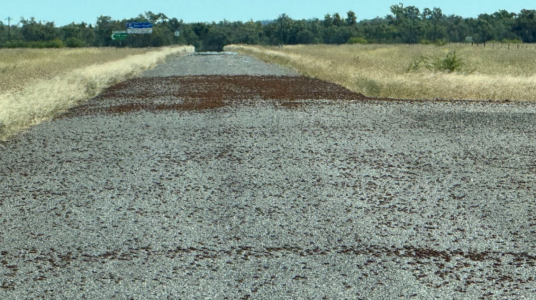Creepy critters invade Australia and sweep through neighbourhoods
By
Gian T
- Replies 0
If you’ve ever seen a cloud of insects darken the sky or a road wriggling with life, you know it’s not just a scene from a nature documentary—it’s a real and present threat for many Aussies right now.
A 'carpet of critters' is on the move, and experts are warning that the infamous Migratory Locust is back in force, threatening crops, pastures, and even the green shirts on your washing line!
After months of wet weather—great for gardens, not so great for farmers—conditions have become perfect for locust breeding.
Swarms have been spotted in huge numbers around Longreach, Muttaburra, Aramac, and Alpha–Moray Downs.
These aren’t just a few stray bugs; we’re talking millions of hungry mouths, all looking for their next meal.
While the Migratory Locust is a native species and does play a role in our ecosystem, when their numbers explode, they become a nightmare for agriculture.
Geoff Penton from Desert Channels, a natural resource management group, explains: 'They will eat everything and anything that looks like green grass. They will even eat green clothing off clothing lines.' (So maybe keep your favourite green shirt inside for now!)
Locusts aren’t picky eaters. In fact, they’re the ultimate opportunists. They’ll devour entire fields of wheat, barley, oats, sorghum, legumes, vegetables, and even fruit trees in a matter of hours.
These are the very crops that fill our pantries and feed our livestock. A big enough outbreak can strip paddocks bare, devastate local economies, and threaten food security for all Australians.
And it’s not just the farmers who feel the pinch. When crops are destroyed, prices at the supermarket can rise, and shortages of staples like bread, beer, and even fresh veggies can follow. It’s a ripple effect that can touch every household.
The Australian Plague Locust Commission (APLC) has confirmed that active locust bands are on the move, with swarms already being seen along rural roads.
Staff from Desert Channels Queensland recently reported seeing 'a carpet of critters' near Muttaburra, including late-instar locusts—meaning they’re almost fully grown and ready to take flight.
The good news? So far, the population hasn’t reached the level that would trigger aerial spraying, but authorities are watching closely.
As winter approaches, locust development should slow down—unless we get more heavy rain, which could lead to another wave of hatching.
Vigilance is key. The APLC is urging landholders, local councils, and anyone in affected areas to report sightings of swarms, hopper bands, or egg-laying activity.
You can call 1800 635 962 or email [email protected]. Early reporting enables experts to track the spread and respond effectively before the situation escalates.
If you’re a landholder, now’s the time to dust off your biosecurity plan and be ready to act.
And for everyone else—keep an eye out for unusual insect activity, especially if you’re travelling through rural areas.
This isn’t the first time locusts have caused chaos in Australia. Major plagues have swept across the country before, with the most recent significant outbreaks occurring in 2010 and 2011, resulting in millions of dollars in crop losses and control efforts.
The combination of climate variability, wet weather, and vast open spaces makes Australia particularly vulnerable to these sudden population booms.
Locusts are fascinating (if slightly terrifying) creatures. When conditions are right—plenty of food, warm weather, and moist soil for egg-laying—they breed rapidly.
As their numbers grow, they change behaviour, forming massive, mobile swarms that can travel hundreds of kilometres in search of food.
It’s a survival strategy that’s worked for millions of years, but it’s a disaster for modern agriculture.
And remember, while these critters might be a menace, a little Aussie community spirit goes a long way in facing whatever nature throws at us.
Stay safe, stay vigilant, and keep those green shirts inside—just in case!

Have you spotted locusts in your area? Are you a farmer dealing with the fallout, or do you remember past plagues? Share your stories, tips, and photos in the comments below.
Read more: Massive invasion spreads across Australia and what you need to know
A 'carpet of critters' is on the move, and experts are warning that the infamous Migratory Locust is back in force, threatening crops, pastures, and even the green shirts on your washing line!
After months of wet weather—great for gardens, not so great for farmers—conditions have become perfect for locust breeding.
Swarms have been spotted in huge numbers around Longreach, Muttaburra, Aramac, and Alpha–Moray Downs.
These aren’t just a few stray bugs; we’re talking millions of hungry mouths, all looking for their next meal.
While the Migratory Locust is a native species and does play a role in our ecosystem, when their numbers explode, they become a nightmare for agriculture.
Geoff Penton from Desert Channels, a natural resource management group, explains: 'They will eat everything and anything that looks like green grass. They will even eat green clothing off clothing lines.' (So maybe keep your favourite green shirt inside for now!)
Locusts aren’t picky eaters. In fact, they’re the ultimate opportunists. They’ll devour entire fields of wheat, barley, oats, sorghum, legumes, vegetables, and even fruit trees in a matter of hours.
These are the very crops that fill our pantries and feed our livestock. A big enough outbreak can strip paddocks bare, devastate local economies, and threaten food security for all Australians.
And it’s not just the farmers who feel the pinch. When crops are destroyed, prices at the supermarket can rise, and shortages of staples like bread, beer, and even fresh veggies can follow. It’s a ripple effect that can touch every household.
The Australian Plague Locust Commission (APLC) has confirmed that active locust bands are on the move, with swarms already being seen along rural roads.
Staff from Desert Channels Queensland recently reported seeing 'a carpet of critters' near Muttaburra, including late-instar locusts—meaning they’re almost fully grown and ready to take flight.
The good news? So far, the population hasn’t reached the level that would trigger aerial spraying, but authorities are watching closely.
As winter approaches, locust development should slow down—unless we get more heavy rain, which could lead to another wave of hatching.
Vigilance is key. The APLC is urging landholders, local councils, and anyone in affected areas to report sightings of swarms, hopper bands, or egg-laying activity.
You can call 1800 635 962 or email [email protected]. Early reporting enables experts to track the spread and respond effectively before the situation escalates.
If you’re a landholder, now’s the time to dust off your biosecurity plan and be ready to act.
And for everyone else—keep an eye out for unusual insect activity, especially if you’re travelling through rural areas.
This isn’t the first time locusts have caused chaos in Australia. Major plagues have swept across the country before, with the most recent significant outbreaks occurring in 2010 and 2011, resulting in millions of dollars in crop losses and control efforts.
The combination of climate variability, wet weather, and vast open spaces makes Australia particularly vulnerable to these sudden population booms.
Locusts are fascinating (if slightly terrifying) creatures. When conditions are right—plenty of food, warm weather, and moist soil for egg-laying—they breed rapidly.
As their numbers grow, they change behaviour, forming massive, mobile swarms that can travel hundreds of kilometres in search of food.
It’s a survival strategy that’s worked for millions of years, but it’s a disaster for modern agriculture.
Stay safe, stay vigilant, and keep those green shirts inside—just in case!
Key Takeaways
- Migratory Locusts are swarming in large numbers across outback Queensland, with sightings reported around Longreach, Muttaburra, Aramac, and Alpha–Moray Downs following favourable breeding conditions.
- These native pests can devastate agriculture by consuming entire fields of crops like wheat, barley, oats and sorghum, threatening food security and causing significant economic losses for farmers.
- The Australian Plague Locust Commission and Desert Channels Queensland have confirmed an active locust outbreak and are urging landholders and councils to report any sightings of swarms, hopper bands or egg-laying activity.
- While current locust numbers remain below the threshold for aerial spraying, ongoing vigilance and early reporting are essential to prevent a major outbreak as winter approaches.
Read more: Massive invasion spreads across Australia and what you need to know








